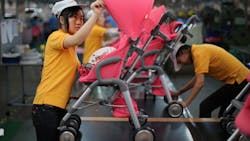China’s producer price index rose at the fastest pace in more than five years in December as the factory to the world swings from being a drag on global inflation to another potential force pushing prices higher.
PPI jumped 5.5% last month from a year earlier, compared to the median estimate of 4.6% in a Bloomberg survey and the 3.3% gain in November. Consumer-price index rose 2.1% versus a 2.2% gain forecast by analysts.
Only four months out of a multiyear factory deflation, the world’s second-largest economy is poised to export inflation around the globe through its supply chains as manufacturers squeezed by higher input costs raise asking prices. Whether that rebound will be sustained hinges on how the global economy fares under a Donald Trump presidency and whether trade tensions flare between the U.S. and China.
Economist Takeaways
"Reflation continues in the factory sector," said Julia Wang, an economist at HSBC Holdings Plc in Hong Kong. "The stable CPI suggests that the reflation is confined mostly in the industrial sector and hasn’t filtered into the real economy. So the PBOC would possibly not respond to it until inflation expands to the real economy."
"Factory reflation is a positive for China’s economy -- real borrowing costs are now negative," Bloomberg Intelligence Chief Asia Economist Tom Orlik wrote in a note. "Rate hikes are part of the policy debate again, especially given the need to support a weak yuan."
"The risk is to the upside for inflation and removes the possibility for near-term policy easing," said Li Wei, the China and Asia economist for Commonwealth Bank of Australia in Sydney.
"High commodity prices will delay the government effort to deal with over capacity," said Raymond Yeung, chief greater China economist at Australia & New Zealand Banking Group Ltd. in Hong Kong. "Producers are tempted to fire the engine again."
Among producer prices, those for mining surged 21.1% in December from a year earlier while raw materials increased 9.8%. PPI rose faster as a weaker currency lifted imported commodity prices, demand for industrial products recovered and the effect of overcapacity reduction kicked in, the National Bureau of Statistics said in a statement released with the data Purchasing prices climbed 6.3% from a year earlier, led by fuel and metals. Consumer prices of food climbed 2.4%, while non-food prices increased 2%. Subdued consumer inflation was due to a high base and slower vegetable price increases, according to the NBS.
By Bloomberg News
About the Author
Bloomberg
Licensed content from Bloomberg, copyright 2016.
